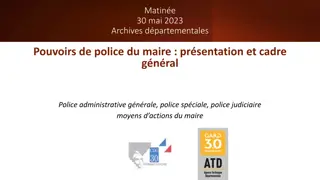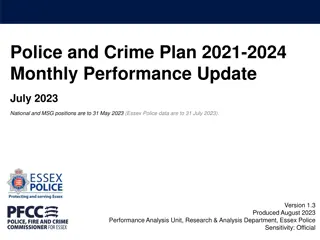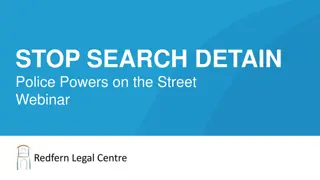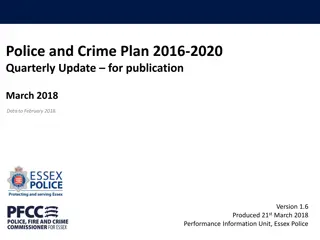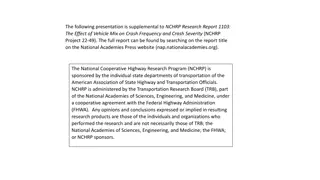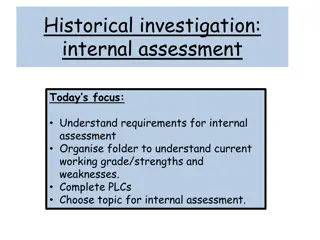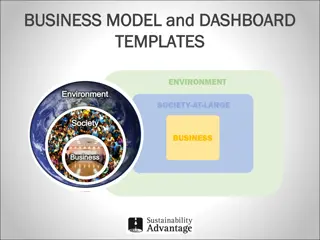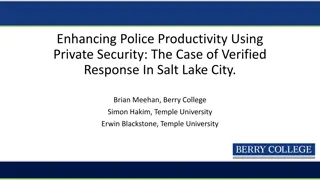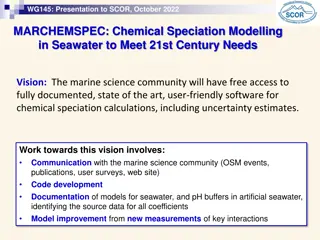Bringing Police Crash Investigation into the 21st Century: Advancing Technologies for Enhanced Reporting
National Transportation Safety Board should advocate for modernizing how State and Local Police investigate and report on motor vehicle crashes. New technologies like laptops, digital cameras, black boxes, and AI programs can significantly improve the accuracy and completeness of crash reports. Adoption of these technologies could provide fresh, comprehensive evidence, eliminate the need for statistical sampling, and enhance efficiency in crash investigations.
Uploaded on Oct 07, 2024 | 4 Views
Download Presentation

Please find below an Image/Link to download the presentation.
The content on the website is provided AS IS for your information and personal use only. It may not be sold, licensed, or shared on other websites without obtaining consent from the author.If you encounter any issues during the download, it is possible that the publisher has removed the file from their server.
You are allowed to download the files provided on this website for personal or commercial use, subject to the condition that they are used lawfully. All files are the property of their respective owners.
The content on the website is provided AS IS for your information and personal use only. It may not be sold, licensed, or shared on other websites without obtaining consent from the author.
E N D
Presentation Transcript
Bringing Police Crash Investigation and Reporting into the 21stcentury Why the National Transportation Safety Board should Advocate that State and Local Police Update how they Investigate and Report on Motor Vehicle Crashes Carl E. Nash, Ph.D. Washington, D.C. August 2, 2016
Role of the NTSB toward Understanding Transportation Crashes NTSB conducts detailed investigations of the most serious crashes of all transportation modes except motor vehicles. In its investigations, NTSB uses all available sources of data including crash recorders (black boxes) and attempts to be at the scene rapidly to obtain fresh, complete evidence. Motor vehicle crashes are different from other modes only in that the number of serious crashes is far too large to permit the kind of detailed investigations conducted by NTSB except in unusual circumstances. NHTSA has struggled for decades with how to get comprehensive, accurate, representative, up-to-date highway crash data. Systems such as NASS and FARS have been imperfect means for fulfilling that need.
New Technologies that Could Enhance Police Crash Investigation and Reporting Low-cost technologies are available that could substantially enhance the accuracy and completeness of police crash reports: - Laptop and tablet computers and software - Digital cameras - On-board Crash Recorders (black boxes) in virtually all new vehicles - Satellite photographs of crash locations - Artificial intelligence programs that can objectively interpret evidence providing estimates of Abbreviated Injury Scale (AIS injury type and severity) and Collision Deformation Classification (CDC to support an estimate of collision energy and momentum change) - Reading devices for direct input of data from drivers licenses, registrations and insurance cards
Advantages of the Adoption of New Technologies for Crash Reporting The quality and completeness of a modern police crash report could rival those of the current NASS reports because: - Evidence available to an officer from the scene, vehicle and people involved is fresh and complete, - There would be no need for statistical sampling: with universal adoption within a state, the result would be a census, and - Artificial intelligence programs could provide reasonable estimates of the severity of a crash and of crash injuries. The use of modern computer technologies would make the process faster, more efficient and accurate. A computer could provide step-by-step instruction to an officer for the conduct of an investigation, integrating it with other responsibilities for clearing the scene, and law enforcement; minimizing the need for extensive training.
Impediments to the Adoption of New Technologies for Crash Reporting NHTSA has been unwilling to initiate a program to encourage state and local police agencies to update how they report on motor vehicle crashes. The apparent reasons are: - Political concerns (perceived resistance to change at the state and local level), - Bureaucratic inertia, and - How to finance the cost of change. There is no prototype system to demonstrate: - The advantages of modern crash investigation and reporting, - That it would not require significant retraining of police officers who report on road crashes, and - That it could decrease the time required to deal with a crash. There is little discussion of whether or how to do this.
Police Crash Reporting Police reporting of crashes is hopelessly out-of-date: photos are rare, sketches of the crash scene and vehicle damage are crude, injury coding (KABCO) is primitive and inaccurate, and vehicle crash recorder data is essentially inaccessible. Police crash investigators have authority, presence and access to obtain the freshest and most complete data on crashes. High quality, complete, timely representative crash data are critical to diagnosing crashes and injuries: road dangers, vehicle safety performance (impact of new designs and materials and safety defects), and changes in roads, traffic and driver behavior. New vehicle technologies (electronics, sensors, self-driving cars) and new fuel economy regulations (lighter vehicles, new materials, advanced energy storage), demand up-to-date crash data to track the safety consequences of these developments.
A Typical Police Accident Report Form Location of the crash Conditions surrounding the crash Identification of drivers, & description of vehicles A crude, hand-drawn diagram of the scene Vehicle impact & damage areas Injured body part, KABCO & transport to medical facility A minimal verbal description of the crash Vehicle occupants & pedestrians
NHTSA is Critically Dependent on PARs PAR data are the basis for all of NHTSA s crash data programs and will continue to be even with their redesign: Fatality Analysis Reporting System (FARS) all fatal crashes, National Automotive Sampling System (NASS) - General Estimates System (GES) PAR data on sampled crashes, and - Crashworthiness Data System (CDS) which samples crashes for detailed investigation based on PAR data. The new Crash Investigation Sampling System (CISS) and Crash Report Sampling System (CRSS) replacing CDS and GES. NASS investigators must wait for PARs to be completed to make case selection. Sampling occurs only every several days. As a result, investigations are delayed by days or even a week: evidence disappears or becomes stale. The consequence is that it is estimated that about 10 percent of the data and photos are lost.
NHTSA Crash Data Program Shortcomings NASS CDS ignores crashes involving pedestrians, pedal cycles, motorcycles, larger trucks, buses, and off-road vehicles (ATVs, ROVs) that use public roads. NASS confuses independent and dependent variables: injury, a dependent variable, is incorrectly used as a major selection criterion. Injury is a function of crash severity and human vulnerability (age, sex, etc.). Correct statistical sampling should be based solely on crash type and severity, the independent variables. Even with injury as a selection factor, NASS is overwhelmed by lower severity crashes. NASS investigations occur after some key data has been erased or has deteriorated (vehicles repaired or disappeared, memories faded, crash scene evidence erased and cleared).
Equipment for a New Approach to Crash Investigation & Reporting Police crash investigators could have a laptop or notebook computer with dedicated software to guide them, receive data, and assess crash parameters. Guidance would include: instructions for taking digital photographs of the vehicle(s) and key aspects of the scene, and instructions for interviewing the people involved in the crash and witnesses, and observing the nature and severity of injuries. Artificial intelligence to estimate crash & injury severity: Collision Deformation Code(s) derived from photographs of the vehicle from which the severity of the crash forces and energy can be estimated, and Abbreviated Injury Scale descriptions of crash injuries using, for example, TraumaHawk, a University of Iowa product.
New Investigation & Reporting Equipment Tools to read VINs, driver s licenses, vehicle registrations, and insurance cards and enter the data into the report. Google Maps show scaled satellite crash scenes. Computer drawing tools can show vehicle trajectories, impact points, and final vehicle rest points, involved guardrails, trees, and such. Guidance for photographing the vehicles and scene. Low-cost tools to download pre-crash speed, pre-crash braking, and safety belt use from vehicle black box crash recorders. (This would require cooperation of automakers to modify crash recorders to facilitate access with appropriate access and privacy protections.) The Internet for timely transmission of completed PARs to police headquarters and a central state database of crashes within a state or into a cloud database.
A Note on Vehicle Crash Recorders Crash recorders installed in all new cars and light trucks collect extensive data from the seconds before a crash. Critical data is pre-crash speed, braking, and restraint use. This black box data can be accessed only by a trained operator using a $10,000 piece of equipment Systems such as GM s OnStar automatically access data from the crash recorder and send it to a central source: where a crash has occurred and its severity. Thus, the technology to make basic black box data accessible for easy download by police investigators is available. Privacy is cited as a concern from such a download. However, the information is currently available to anyone with the equipment and training. Furthermore, such data can be segregated within a report and file to protect privacy.
Advantages of Modern Crash Reporting An investigating officer has excellent access to fresh, relatively undisturbed, and complete information on a crash. National Automotive Sampling System may not be needed. FARS and GES would be totally unnecessary. NHTSA could use data mining software to identify special safety issues, to understand types of crashes and crash injuries; and to evaluate changes in automotive transportation resulting from new vehicle designs, safety standards and programs, and human behavior (use of electronic devices, for example). Quality crash data on all road crashes including pedestrians, cyclists, motorcyclists, and commercial trucks and buses (critical for the Federal Motor Carrier Safety Administration). NHTSA could continue to conduct special studies if additional details were needed for analysis or evaluation.
Whats in it for States and Police Agencies? The advantages to States and police agencies are: The cost could be paid from NHTSA s 405 Highway Safety Program grant funds (currently $38 million per year for data improvement) and the change can be phased in. The new system should make crash reporting faster, more efficient and accurate by reducing manual input. Training requirement would be minimal because the software could guide an officer through the process of dealing with a crash scene and reporting on it. The enhanced data could focus all types of safety programs. The 21st century technology would make police crash reporting work more professional.
Cost and Implementation New software and hardware are critical to make a conversion attractive to the police. It would be relatively inexpensive to develop (we estimate hundreds of thousands of dollars). Cost of equipment and training can be paid from NHTSA s 405 Highway Safety Program grant funds appropriated for data improvement. Implementation would require backing of NHTSA and FMCSA plus a coalition of Governor s Highway Safety Representatives, police organizations, Motor Vehicle Administrators, safety advocacy groups, and others. Auto makers would have to modify vehicle crash recorders to permit and facilitate downloading of basic pre-crash information: pre-crash speed and braking and occupant restraint use.
Toward Adoption Experts in coding have estimated that developing prototype software would cost around $250,000. A limited number of units could be built using currently available portable computers for several thousand dollars each. Once a system is developed, a police agency could be enlisted to conduct a trial. The head of the National Park Police, for example, has expressed interest. The cost of a small pilot program might be around $500,000 for equipment and training. NHTSA and FMCSA must be enlisted to join in advocating (and funding) adoption. NHTSA has been extensively briefed. Once it has been demonstrated, a combination of the resulting reports and testimonials by officers who have used it could be used to enlist broader support for use of the system. Existing police software companies might be enlisted to produce and promote the first generation units.



